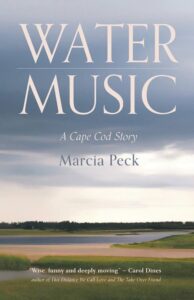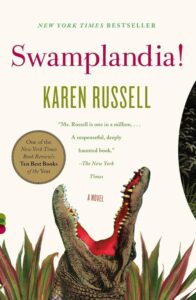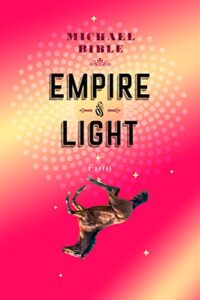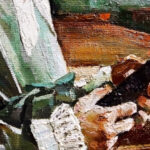On Cumberland Island, Georgia, between the twisted oaks of the maritime forest and the broad, white dunes of the ocean-facing coast, I met a feral horse. He—a stallion straight from the cover of Black Beauty, if a little scragglier—had positioned himself on the narrow causeway that crossed a freshwater pond, and, by his snorting and head tossing and the way he ripped at the earth with his hooves, it was clear that he did not intend to let me cross.
The horse moved towards me in a kind of stiff march. My friends scattered. I turned away at an angle (would he charge if I showed my back?) and walked into the woods beside the trail. I tried not to look at the horse. I shed my red jacket (were pissed-off feral stallions like Spanish bulls?).
In the scrawny pines, I felt better. I was off the trail, but the stallion was nowhere in sight. I conferred with my friends. I took out my map. We could meet the trail at a different point, but we would have to, eventually, cross the causeway if we wanted to see the dunes. Over my shoulder, there was a crackling of leaves, the sound of wood breaking.
“Behind you!” my friend (actually) said.
It was the stallion, only yards away. He had followed me into the woods (why hadn’t I heard him sooner?). Again, I cut my eyes from the horse and walked away, deeper into the pines. I tried to stay calm. I imagined the hard crescents of the stallion’s hooves cutting into my back, but they never came.
***
While this was (so far) my most hostile encounter with the feral horses of Cumberland Island—the descendants of a population imported from Globe, Arizona by the Carnegies in the 1920s—it was one of many. During my time researching the island’s horses and landscape, tourists would sometimes ask me on the ferry from St. Mary’s, “What are the chances we’ll see a wild horse?”
Though the 200-odd feral horses can be viewed reliably on the grounds of the ruined mansion, picking over the few fallow fields of the island, or walking the sand trails in small, somber trains—typically a skinny mare and her foals—there are no “wild” horses on Cumberland Island. Only feral domestic stock left to eke out what living they can on the island, where browse is scarce, freshwater is limited, and their lifespan is less than half of what it might be. (For those interested, recent journalism on the horses’ situation can be found here.)
It was my fascination with the horses of Cumberland, with the words “wild” and “feral” and the way they move in our imaginations, and—yes—with the natural beauty and diversity of life on Georgia’s largest barrier island that led me to write my first novel, the coming-of-age thriller, Bomb Island.
On my fictionalized version of Cumberland Island, called Bomb Island for the unexploded atomic bomb sunk off its coast, it’s not horses, but the white tiger, Sugar, that stalks people from the cover of the saw palms.
First, I wanted to write Jaws, then an artists’ romance, then climate fiction. As it often goes, all of these ideas mixed and folded and accordioned into the novel as it came to be, but it occurs to me now, years later, that the deepest root of the book might be found at the base of that causeway, with that irate dude-horse tearing up the ground, looking like a living specter of comeuppance for his and his forebears’ stranding.
Like the characters in Bomb Island, I grew up feeling at home in the woods, hiking and hunting; this was one of many times that I was humbled by the natural world. Like the other authors on this list, I found conflict, catharsis, even pleasure in the risk of the wild.
Here are five books that will transport you to wild worlds this summer, from which you may never return:

Water Music: A Cape Cod Story, Marcia Peck (2023)
Lily Grainger and her family find a new home on the edge of the continent, where she grapples with fragmented family dynamics and new friendships. Set against Massachusetts’ scenic coastline, the novel explores identity, belonging, and redemption. Through Lily’s journey of self-discovery, Peck captures the beauty and complexity of Cape Cod, weaving a tale of love, forgiveness, and the small ways that we hold each other together.

Swamplandia, Karen Russel (2011)
A haunting, coming-of-age story that centers the Bigtree family’s alligator-wrestling theme park, located on a mangrove island off the coast of Florida. The novel follows the Bigtree children on their quest to save their home and sister—a journey that will take them to the brink of the underworld. Magical realism animates an exploration of family grief and resilience amidst lush, otherworldly landscapes and eccentric characters.

Teenager, Bud Smith (2022)
In an intimate reflection on adolescence, Teenager follows two lovers as they escape their small New Jersey town for a road trip across the country. Smith navigates the complexities of life in violent transition in prose that is sharp and feeling, rendering a vision of America is raw and unflinching, as likely to kill you as it is to make you whole.

The Virgin Suicides, Jeffrey Eugenides (1993)
A chilling suburban drama narrated by a group of boys fascinated by the mysterious deaths of their neighbors, the Lisbon sisters. The Virgin Suicides makes space for itself as a contemporary classic that takes on the difficult territory of abuse, oppression, loss of innocence, and intrigue in a novel that renders profound tragedy with dark humor. Alongside Eugenides’ young characters, readers are compelled to immerse themselves in a mystery hidden in plain sight.

Empire of Light, Michael Bible (2018)
A hypnotic novel set in the American South that follows the rambling of the hapless Alvis Maloney. In small-town North Carolina, Maloney finds new friends and trouble in a surreal exploration of companionship, belonging, and redemption. Like his teacher, Barry Hannah, Bible’s prose is cutting, bizarre, even feverish. Empire of Light evokes and updates the Southern Gothic tradition in a modern narrative rife with melancholic beauty, wanderlust, and yearning.
***


















